atherectomy
What is an atherectomy?
 An atherectomy is a procedure to remove plaque from an artery (blood vessel). The removal of plaque widens the artery, allowing blood to flow more freely to the heart muscles. In an atherectomy, plaque is shaved or vaporized with tiny rotating blades or a laser at the end of a catheter (a thin, flexible tube).
An atherectomy is a procedure to remove plaque from an artery (blood vessel). The removal of plaque widens the artery, allowing blood to flow more freely to the heart muscles. In an atherectomy, plaque is shaved or vaporized with tiny rotating blades or a laser at the end of a catheter (a thin, flexible tube).
This procedure is used to treat peripheral arterial disease and coronary artery disease. Atherectomy is sometimes done on patients with very hard plaque or on patients who have had angioplasty and stents before but still have plaque blocking blood flow.
What is plaque?
Plaque is the buildup in the arteries of fat, cholesterol, calcium, and other substances. When plaque builds up, it can block blood flow or rupture, causing blood clots. This buildup of plaque is called atherosclerosis. Atherectomy is a treatment for atherosclerosis.
How is an atherectomy performed?
The atherectomy procedure is performed in a cardiac catheterization laboratory. Before an atherectomy, the patient is given sedatives to help him relax. Then a catheter is gently inserted into an artery, usually in the groin or upper thigh area. It is then guided through the blood vessel to the heart. When in place, the dye is injected through the catheter and into the coronary arteries. An x-ray is taken to help the doctor locate the area that is blocked or narrowed. The doctor then uses tiny blades or a laser, attached to the end of the catheter, to cut or vaporize the plaque.
After atherectomy, an angioplasty or stenting procedure is sometimes performed. Once the treatment is complete, the catheter is removed. Most patients go home after about 24 hours.
Is the intervention risky?
The success rate of this type of intervention is excellent, since it is "close to 99%". Complications are therefore rare, but can however be "extremely serious". The main risks are:
A perforation, "the artery is often tortuous, especially in women", explains the cardiologist. "When the coronary artery is affected, it can lead to cardiac tamponade, which requires emergency surgery.
A blockage of the bur, which may lead to occlusion of the artery, "hence the importance that this procedure is performed by an experienced cardiologist. He will be able to judge whether the risk of the intervention is higher than the benefit".
What medical follow-up?
After the intervention, 24 hours of follow-up in hospital are generally sufficient. Subsequently, “the patient must be seen again within three months, either by the cardiologist who performed the procedure, or by his own cardiologist”. After which, medical monitoring must be ensured and treatment taken "for life".